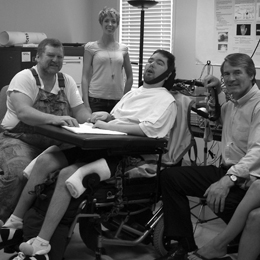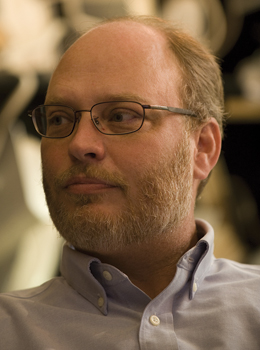Turning Thoughts into Words

A
“brain-computer interface” system picks up signals from an electrode
implanted in Erik’s brain and transmits them via FM radio waves to a
Neuralynx recording system. By means of a neural decoder and
synthesized voice, vowel sounds are produced in real-time as Erik
Ramsey thinks about each letter.
Diagram courtesy of Frank Guenther
Before the accident, Erik Ramsey was “a typical teenager,” according to his dad, Eddie Ramsey. He liked to draw and skateboard. He liked sports and girls. But on a November night in 1999, everything typical about Erik Ramsey’s life ended. A car crash caused a brain-stem stroke that left him with “locked-in syndrome”—completely paralyzed but with total cognitive and sensory awareness. Ramsey, now 24, has almost no voluntary control over his body, except for his eyes, which he uses to answer questions—by looking up for yes or down for no. Now, thanks to a collaboration between Neural Signals, Inc., a company in the Ramseys’ home state of Georgia, and Frank Guenther, a professor of cognitive and neural systems, Ramsey may one day regain his ability to speak. With funding from the National Institutes of Health (NIH), researchers are creating a “speech prosthesis” that combines a wireless electrode and transmitter from Neural Signals, Inc. implanted in Ramsey’s brain, with a voice synthesizer run by software based on a computer model of the brain’s language centers developed by Guenther’s lab. Together, they aim to turn Ramsey’s thoughts into words.
“It’s kind of equivalent to watching your baby learn to walk. He’s got the first steps out of the way, and soon he’ll be off.”
The collaboration is about two years old, but since 1992 Guenther and his lab team have been working on a computational model of how the brain controls speech. Their model mimics the neural networks involved in producing words—from moving the jaw, lips, and tongue to babbling to processing “auditory targets” stored in the brain of how a word is supposed to sound. Continually refined with data from functional magnetic resonance imaging of people’s brains performing speech tasks, the model learns to control a computer-simulated vocal tract and translate neural signals into words.

Erik Ramsey rests between experimental sessions with his father, Eddie Ramsey (left), Neural Signals Inc. founder Philip Kennedy, and lab technician Jess Bartels.
Photo courtesy of Frank Guenther
In the summer of 2006, Guenther was contacted by Philip Kennedy, founder of Neural Signals, Inc., who had implanted an electrode about six millimeters long into Ramsey’s brain, in the area that controls the tongue, jaw, and lips. The electrode could wirelessly transmit the pulses of about 40 neurons surrounding it. Kennedy’s team had collected extensive data from the electrodes, gathered when researchers asked Ramsey to imagine speaking specific words. But they couldn’t decode it. Up to a billion neurons are activated when we speak, says Guenther, so to glean much from just 40, “you need to have extremely sensitive techniques.”
Guenther’s lab used their neural model of speech to guide the design of decoder software that learned to read Ramsey’s mind as he imagined saying vowel sounds. In a clinical trial last year, they were able to predict what vowel sound Ramsey was thinking of with 80 percent accuracy, but not in real time. In February, they used an improved decoder and a new training protocol in which Ramsey imagined “singing along” to a series of vowel sounds that moved, for example, from oooh to ahhh. Once the decoder had been “trained” to recognize Ramsey’s signal patterns, it was able to drive a synthesized voice that produced the vowel sounds as soon as Ramsey thought them.

Frank Guenther
“Everybody was just ecstatic that day,” says Eddie Ramsey—including Erik, who can still laugh, and did. The next step is consonants, which are more complex, because they involve the closing of the vocal tract. Meanwhile, Neural Signals, Inc., has FDA approval to implant electrodes in four more patients, which would accelerate the development and refinement of the decoder software.
As for Ramsey’s chances of being able to speak again, his father has no doubt it will happen. “It’s kind of equivalent to watching your baby learn to walk,” he says. “He’s got the first steps out of the way, and as soon as he’s got his footing under him, he’ll be off.”